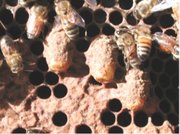Queen bee
|
|
Honeybee queens are developed from larvae selected by worker bees to become sexually mature. In each hive or colony, there is normally only one adult, mated queen, who is the mother of the bees of the hive, although there are exceptions.
| Contents |
Development
Royal_jelly_0030.JPG
The queen develops more fully than sexually immature workers because she is given royal jelly, a secretion from glands on the heads of young workers, for an extended time, and because she is given a specially constructed cell, which is larger than the cells of normal brood comb, and also is oriented vertically instead of horizontally.
Opened_queencell_0021.JPG
| Type | Egg | Larva | Cell capped | Pupa | Developmental Period | Start of Fertility |
|---|---|---|---|---|---|---|
| Queen | 3 days | 5 1/2 days | 7 1/2 days | 8 days | 16 days | approx. 23 days |
There are three kinds of queen bee cells:
- large, solitary cells, usually on the bottom of the comb (or in a hole if in the middle of the comb), constructed by the workers when they want to replace the queen - a process called supercedure.
- smaller grouped cells, at the same positions as previous, constructed when the colony is intending to swarm;
- solitary cells usually on the surface of the middle of the comb, constructed as expansion of a normal cell if a colony suddenly lost its queen.
The best queens emerge from replacement cells. As the young queen larva pupates with her head down, the workers cap the cell with beeswax. When ready to emerge, she will chew a circular cut around the cap of her cell. Often the cap swings open when most of the cut is made, so as to appear like a hinged lid. Queen cells that are opened on the side indicate that the virgin queen was likely killed by a rival.
When the young queens are ready to emerge, they often begin to "pipe" , a shrill peeping, which is thought to be a challenge to other emerged or ready to emerge virgins. Unless the workers restrain them, emerged virgin queens will quickly find and kill rivals. During the swarm season, workers may separate young queens, thus keeping several alive at once for longer than a brief period. The extra queens may go with swarms or afterswarms to sort out their survival in a new home.
Reproduction
When one queen survives in a colony, she will go out on a sunny, warm day to mate with 12-15 drones. She has only a limited time to mate, and if she is unable to fly because of bad weather and remains unmated, she will become a "drone layer." Drone laying queens usually mean the death of the colony, because the workers have no fertilized (female) larvae from which to raise a replacement. If there is a deficit of drones, or the weather provides too brief a window for full mating, the queen may be able to function briefly, laying fertilized eggs for a few weeks or months, until she runs out of sperm cells and ceases laying fertilized eggs much sooner than the normal 2-3 year life span of queens.
If workers realize their queen is failing, and the weather will allow a replacement to be raised and mated, the bees can "supersede" the queen. However, supersedure will fail in winter in colder climates, because there are no drones and the queens cannot fly to mate.
Daily life for the queen
Queen-022f.jpg
Although the name might imply it, a queen has no control over the hive. Her sole function is to serve as the reproducer; she is an "egg laying machine." A good queen of quality stock, well reared with good nutrition and well mated, can lay about 2,000 eggs per day during the spring build-up and live for two or more years. She lays her own weight in eggs every couple of hours and is continuously surrounded by young worker attendants, who meet her every need, giving her feed and disposing of her waste. They also lick her body for the pheromones that are needed for well being of the colony.
Because the social structure is so complex and fixed, a honeybee colony can be thought of as a single organism, and the individual bees as simply cells of the organism; they cannot survive on their own. The queen is responsible for the reproduction of the "cells", but also is responsible through her own pheromone production for the reproduction of the whole colony. This usually takes place in the spring and is called swarming.
Identification
| Color | Used for years ending in | |
| white | 1 or 6 | |
| yellow | 2 or 7 | |
| red | 3 or 8 | |
| green | 4 or 9 | |
| blue | 5 or 0 | |
The queen bee is noticeably longer than the worker honeybees surrounding her. Even so, in a hive of 60,000 to 80,000 honeybees, it is often difficult for beekeepers to find the queen with any speed: for this reason, many queens in non-feral colonies are marked with a light daub of paint on their thorax. The paint used does no harm to the queen, and makes her much easier to find when necessary. Although the color is sometimes randomly chosen, professional queen breeders use a system whereby the color of a queen's dot indicates what year she hatched (therefore aiding beekeepers who are deciding whether their queens are too old to maintain a strong hive, and need replacing). Sometimes, even a tiny plate is used with the number of the queen.

